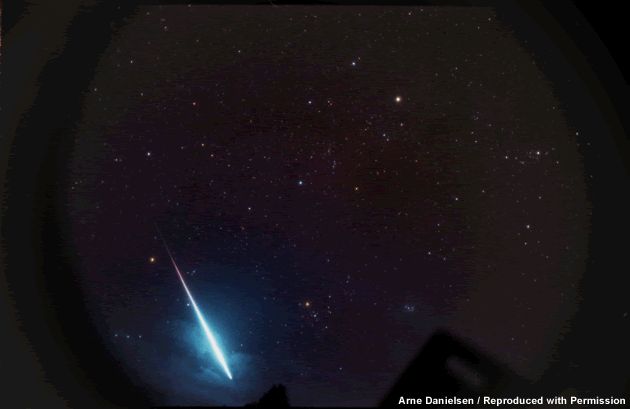Strong Leonid Meteor Shower Expected Nov. 18

If you live in Western Europe or eastern North America, put a big circle on your calendar around Saturday, Nov. 18. If that night is clear, bundle up warmly and head outside because you may be able to catch a glimpse of an intense, albeit brief display of Leonid meteors.
The Leonids are composed of the dusty debris that has been shed by the comet Temple-Tuttle, a small celestial body that orbits the Sun at 33-year intervals. In those years during and then for several years after the comet has swept through the inner solar system, it has had a propensity for producing spectacular meteor displays; meteors falling by the hundreds, if not thousands per hour.
These "shooting stars" all apparently emanate from the constellation of Leo, the Lion. Hence the name "Leonids."
The great years
The comet last passed the Sun and Earth in 1998, and from that year through 2002, the Leonids produced showers in which meteors fell at rates of more than a thousand per hour-displays that astronomers call meteor storms. [Images from 2001: Gallery 1, 2, 3, 4]
Since 2003, however, with Temple-Tuttle having receded back into the far reaches of the solar system, the Leonids have been disappointing, barely producing more than 10 meteors per hour.
It appeared that the chances of any more spectacular Leonid displays were over for many years to come. But that might not be case, if the calculations of several reputable meteor scientists prove to be correct.
Breaking space news, the latest updates on rocket launches, skywatching events and more!
Prediction for 2006
Apparently, a rather narrow but dense ribbon of dust was shed by comet Temple-Tuttle when it passed the Sun in 1932. When the Earth interacted with that dusty trail back in 1969, it produced a brief bevy of some 200 to 300 meteors in less than hour.
In 2006, Earth will be nearly twice as far away from the comet as opposed to 1969, but expectations are that as many as 100 to 150 Leonids may streak across the sky in only an hour's time as we interact with that decades-old ribbon of debris again.
The expected time of peak activity is 11:45 p.m. EST on the night of Nov. 18.
Where to watch
For those living in eastern North America, the constellation of Leo will be rising in the eastern sky. Unfortunately, those living across the central and western parts of the United States and Canada will be out of luck, since Leo will not yet have risen and the expected peak of the display will be over when Leo finally comes above the horizon.
Skywatchers in Western Europe will have ringside seats: The peak is due early on Sunday morning, Nov. 19 at 4:45 GMT. Leo will be high in the southeast sky, just before sunrise affording the very best Leonid views.
Meteor watching is easy. Simply find the darkest location you can with a clear view of the eastern horizon. Then go out and look up. Binoculars and telescopes are of no use [meteor watching tips].
SPACE.com will provide a detailed viewer's guide to the 2006 Leonid meteor shower on Nov. 17.
- Comets, Meteors & Myth
- Meteors and Meteor Showers: How They Work
- The Leonid Meteor Shower: Sowing the Seeds of Life?
- Earthgrazers and Fireballs: The Strange Side of the Leonids
- Does Anyone Ever Get Hit by Meteors?
- Tips on Meteor Shower Photography
- The Power of a Shooting Star

Joe Rao is Space.com's skywatching columnist, as well as a veteran meteorologist and eclipse chaser who also serves as an instructor and guest lecturer at New York's Hayden Planetarium. He writes about astronomy for Natural History magazine, Sky & Telescope and other publications. Joe is an 8-time Emmy-nominated meteorologist who served the Putnam Valley region of New York for over 21 years. You can find him on Twitter and YouTube tracking lunar and solar eclipses, meteor showers and more. To find out Joe's latest project, visit him on Twitter.
